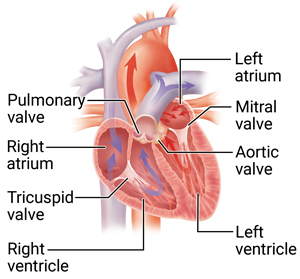Anatomy and Function of the Heart Valves
What are heart valves?
The heart has four chambers: two upper chambers (atria) and two lower chambers (ventricles). Blood passes through a valve before leaving each chamber of the heart. The valves prevent the backward flow of blood. Valves are actually flaps (leaflets) that act as one-way inlets for blood coming into a ventricle and one-way outlets for blood leaving a ventricle. Normal valves have three flaps (leaflets), except the mitral valve. It only has two flaps. The four heart valves are:

-
Tricuspid valve. This valve is between the right atrium and the right ventricle.
-
Pulmonary valve. The pulmonary valve is between the right ventricle and the pulmonary artery.
-
Mitral valve. This valve is between the left atrium and the left ventricle. It has only two leaflets.
-
Aortic valve. The aortic valve is between the left ventricle and the aorta.
How do the heart valves work?
As the heart muscle contracts and relaxes, the valves open and shut. This lets blood flow into the ventricles and atria at alternate times. Here is a step-by-step description of how the valves work normally in the left ventricle:
-
When the left ventricle relaxes, the aortic valve closes and the mitral valve opens. This lets blood flow from the left atrium into the left ventricle.
-
The left atrium contracts. This lets even more blood flow into the left ventricle.
-
When the left ventricle contracts, the mitral valve closes and the aortic valve opens. This is so blood flows into the aorta and out to the rest of the body.
-
While the left ventricle is relaxing, the right ventricle also relaxes. This causes the pulmonary valve to close and the tricuspid valve to open. This allows blood that was returned to the right atrium from the body to then flow into the right ventricle.
-
When the left ventricle contracts, the right ventricle also contracts. This causes the pulmonary valve to open and the tricuspid valve to close. Blood flows out from the right ventricle to the lungs before it is returned to the left atrium as fresh, oxygenated blood.
What is heart valve disease?
Heart valves can have several problems. These include:
-
Regurgitation (a leaky valve). This means that the valve doesn't fully close, and the blood flows backward through the valve. This results in leakage of blood back into the atria from the ventricles in the case of the mitral and tricuspid valves. Or it leaks back into the ventricles in the case of the aortic and pulmonary valves. This can cause the chambers to be overworked because they have to pump the extra blood that was returned. Over time, this can cause structural and functional changes in the heart chambers. These changes prevent the chambers from pumping blood normally.
-
Stenosis (a narrowed valve). With stenosis, the valve opening is narrowed, and the valve doesn't open correctly. This makes it harder for the heart to pump blood across the narrowed valve. The heart must use more force to pump blood through the stiff (stenotic) valve or valves. This can also cause structural and functional changes to the different chambers of the heart. These changes prevent the heart from pumping blood normally.
-
Atresia. This means that the valve opening doesn't develop normally during childhood. This prevents blood from passing from an atrium to a ventricle, or from a ventricle to the pulmonary artery or aorta. Blood must find another route. This is usually through a problem present at birth (congenital). This might be an atrial septal defect or a ventricular septal defect. This acts as another route for the blood to move through the heart
When heart valves fail to open and close as they should, the damage to the heart can be serious. The harm can affect the heart's ability to pump blood through the body.
Online Medical Reviewer:
Daphne Pierce-Smith RN MSN
Online Medical Reviewer:
Rajadurai Samnishanth Researcher
Online Medical Reviewer:
Stacey Wojcik MBA BSN RN
Date Last Reviewed:
4/1/2025
© 2000-2025 The StayWell Company, LLC. All rights reserved. This information is not intended as a substitute for professional medical care. Always follow your healthcare professional's instructions.